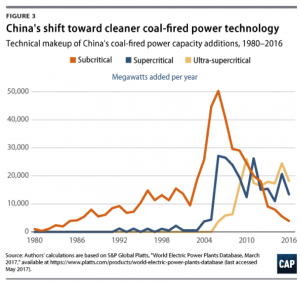Coal is still supplying 62 percent of China’s energy needs, according to 2016 data in BP’s Statistical Review of World Energy, compared to 15 percent for the United States. Further, according to China’s National Bureau of Statistics, consumption of coal in China increased 0.4 percent in 2017, despite Beijing’s push to promote less-polluting energy sources. To deal with its major pollution problems, China, however, is focusing on clean coal technology—supercritical and ultra-supercritical plants that are about twice as efficient as subcritical boilers. (See chart below.) China represents 80 to 90 percent of the global market for advanced coal combustion power generation systems and associated environmental control systems. Not only is China building efficient coal plants in its own country, but Chinese companies are helping to build or finance hundreds of coal-fired power plants around the world. One such project is Kenya’s first 1050-megawatt coal-fired plant costing $2 billion located on some 975 acres.
Source: Center for American Progress
China’s Coal-Fired Projects around the World
China is building and/or financing over 200 coal-fired power plants in 31 countries–Mongolia to Zimbabwe, including countries like Kenya that had no previous coal plants. (See map below.) The coal plant in Lamu, Kenya will be the first of its kind in East Africa and will power an adjacent 32 berth deep-water port that is part of a plan to transform Kenya into an industrializing, middle-income country by 2030. It is financed with Chinese, South African, and Kenyan capital and built by the state-owned Power Construction Corporation of China. Power China has also constructed coal plants in Indonesia and Pakistan and is the 12th-largest developer of coal plants in the world.
Excluding projects in South Africa, over 100 coal-generating units are in various stages of planning or development in 11 African countries, and China is financing about half of them. The combined capacity of the units is 42.5 gigawatts—over eight times the region’s existing coal capacity. While not all are being financed by China, almost all are financed by foreign investment.
Pakistan is committed to building as many as 12 new coal-fired power plants over the next 15 years as part of a large infrastructure investment project that China and its partners are funding. About $33 billion will be spent on 19 energy projects that include coal-fired power plants, transmission lines, and other infrastructure as part of the China-Pakistan Economic Corridor. The majority of the new generating capacity (roughly 75 percent) will come from the new coal plants.
Chinese Companies Are Involved in More Than 200 Coal Projects in 31 Countries
Coal power projects with Chinese financing, construction or ownership:
Source: New York Times
U.S. vs. Chinese Coal Plants
As mentioned above, China is building advanced technology coal plants that are more efficient than most coal-fired power plants in the United States. An analysis of the top 100 most efficient coal plants in China and the United States shows major differences in advanced technology. While the top U.S. coal plants were built between 1967 and 2012, China’s top coal plants were built between 2006 and 2015. Of China’s 100 top plants, 90 are ultra-supercritical; while the United States has just one ultra-supercritical plant. China, however, still has a lot of dirtier and older coal plants. Of the 920 gigawatts of coal capacity in China, 19 percent is ultra-supercritical, 25 percent supercritical, and 56 percent subcritical. While China has canceled some coal-fired capacity due to lack of demand growth, China still plans to increase its coal-fired power plants to almost 1,100 gigawatts, which is over three times the coal-fired capacity of the United States.
Source: Vox
An explanation of the differences in these plant types is as follows:
Subcritical: In these conventional power plants, coal is ignited to boil water, the water creates steam, and the steam rotates a turbine to generate electricity. The term “subcritical” indicates that internal steam pressure and temperature do not exceed the critical point of water—705 degrees Fahrenheit and 3,208 pounds per square inch.
Supercritical: These plants use high-tech materials to achieve internal steam temperatures in the 1,000–1,050 degrees Fahrenheit range and internal pressure levels that are higher than the critical point of water, thus spinning the turbines much faster and generating more electricity with less coal and reduced emissions of criteria pollutants and carbon dioxide.
Ultra-supercritical: These plants use additional technology innovations to bring temperatures to more than 1,400 degrees Fahrenheit and pressure levels to more than 5,000 pounds per square inch, thus further improving efficiency.
Conclusion
China still is using coal for over 60 percent of its energy requirements despite its pledge to the Paris Accord. With abundant coal resources, China continues to use coal to provide energy to its 1.3 billion people. That population, however, is demanding cleaner air from pollutants such as sulfur dioxide, nitrous oxides, and particulate matter, so China is wisely building supercritical and ultra-supercritical power plants in China and using the expertise gained from building them at home to gain new business and influence building coal plants abroad.
